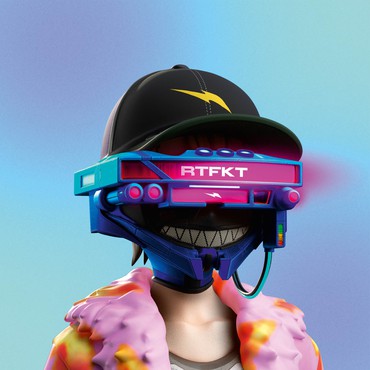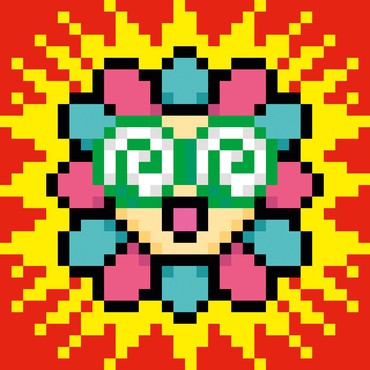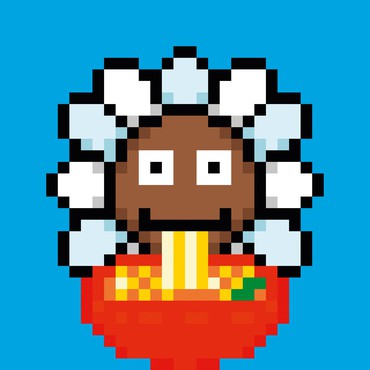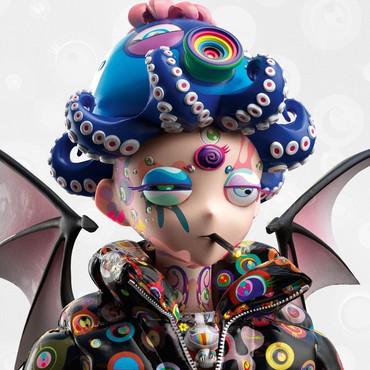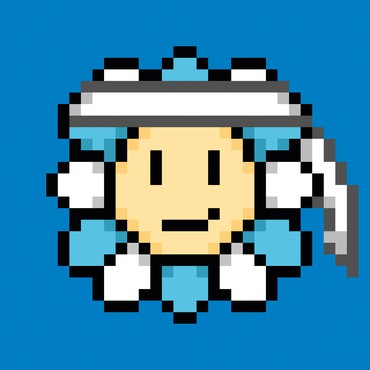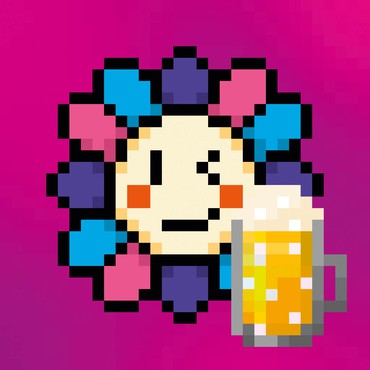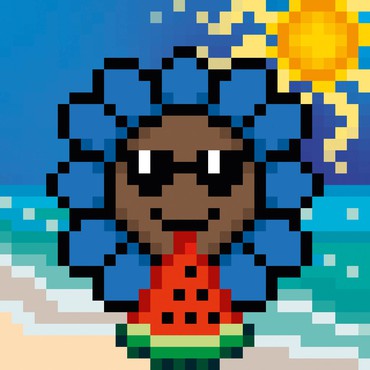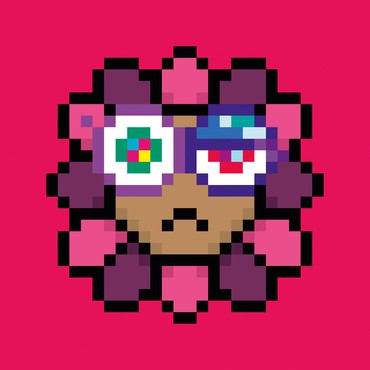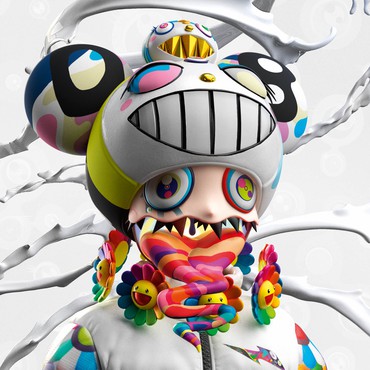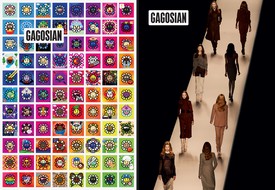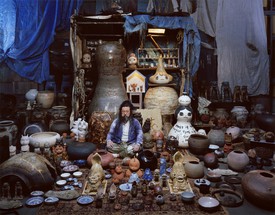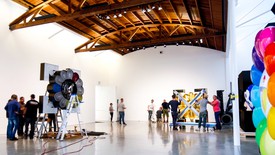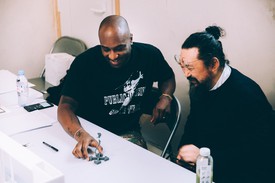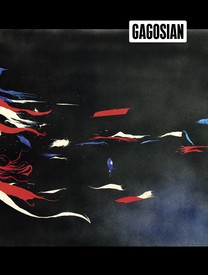
Wyatt Allgeier is a writer and an editor for Gagosian Quarterly. He lives and works in New York City.
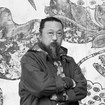
Takashi Murakami earned a PhD from the Tokyo University of the Arts Graduate School of Fine Arts. He began exhibiting his work while still at the university and in 1996 established the Hiropon Factory studio (today Kaikai Kiki) to produce it. In addition to making and marketing Murakami’s art and related work, Kaikai Kiki functions as a supportive environment for fostering emerging artists. With the curation of the 2000 Superflat exhibition, Murakami advanced the Superflat theory of Japanese art. He has exhibited widely both in Japan and overseas. Photo: Claire Dorn
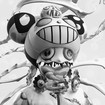
RTFKT is a creator-led organization that uses the latest in game engines, NFTs, blockchain authentication, and augmented reality, combined with manufacturing expertise, to create one-of-a-kind sneakers and digital artifacts.
Wyatt AllgeierHow did you get introduced and start working together?
RTFKTWe’ve all been huge fans of Takashi-san. He’s been a part of our history since day one, even before we officially started RTFKT. When the three of us met, he was the artist we wrote down in our “dream to work with” list. Then one day we saw that Takashi was following us on Instagram. This was when we were launching our Punks sneakers project. We immediately sent him a message, telling him we loved him and his art and that we’d love to do something together one day. This was done mostly via emojis in our DMs.
Takashi MurakamiMy awakening to the metaverse happened in the summer of 2020, the first year of the pandemic, when I saw the way my children interact with the video game Animal Crossing: New Horizons. One day they were watching some fireworks display within the game while talking on Zoom with their school friends (whom they could no longer meet in person), admiring wholeheartedly how beautiful it was. I saw the reality of our shifting values when I realized that these children could see beauty within a small video-game screen.
This experience was similar to my own when I first encountered contemporary art, at the age of twenty-six: I was shocked by the gap between what you saw and the concept, and I realized that once I understood the context behind the gap, the artworks took on an entirely different appearance. I wanted to roar in excitement. So I simplistically decided to make a game, thinking it shouldn’t be too hard to make one in the style and level of the Tamagotchi game. I looked for a developer and found Yoshihisa Hashimoto.
One day during a development meeting, Hashimoto-san said, “Have you seen the craziness around NFT art at the auctions?” He gushed about the Beeple auction and related news, including CryptoPunks, CryptoCats, and, yes, RTFKT: “They’re making AR sneakers! Doesn’t that connect to the kinds of things you did with ComplexCon?” Then he went back to the subject of our Tamagotchi-style game, but six months or so later, RTFKT reached out to me for some reason, proposing a collaboration. I was totally taken by surprise. The tone of their message was so frank and carefree, typical of energetic young people, so I thought it could be a lot of fun and decided to join them.
RTFKTA couple of months later, while working on our Clone X project—a series of NFT avatars conceived as three-dimensional figures bearing distinctive motifs—we thought we should ask Takashi if he’d like to be a part of it. We DM’d him, again on Instagram, and then got on a legendary call where he showed us around his amazing studio and we agreed that we could do something incredible together. Then we just got to work!
TMI kept sending images according to RTFKT’s requests and ideas. They were creating the Clone X images using a quite realistic type of modeling with 3D CG, and I happened to be working on sculpture using 3D files, so we managed to exchange files and data quite smoothly.
WARTFKT, what were some of your initial ideas once it was clear that the collaboration was picking up steam?
RTFKTWe had a series of realizations right at the start. One, it’s great to meet your idols, because they may be even more talented and cooler than you expected. Two, Takashi’s work is structured by a methodology and artistry that aren’t limited to any one medium. He gets the culture, and understood very early on that we were in the middle of a revolution. Three, it doesn’t matter where in the world you are or what ecosystem you’re a part of, you can merge worlds and invent with no limits if you’re good at what you do and have a vision.
TMIt’s true. I’ve discussed the project with RTFKT mainly on Zoom. In fact I’ve yet to meet them in person. Everyone from their team attended our calls from different locations—Costa Rica, Paris, Utah, Dubai . . . I saw how they managed to execute a very complex project while scattered across the world, and was shocked by the difference between their reality and mine. Truly, I was made to acknowledge the generational difference.
WACan you explain what a digital artifact is? What distinguishes it from other endeavors you both engage in?
RTFKTIn video games, we grew up with the term “artifacts.” These are the items you find at the end of quests, or loot in your explorations, and use to customize your character and level up. We’ve been seeing our releases as cultural artifacts and collectibles that help shape your identity in the metaverse and build on your story. The NFT is the medium we’ve been waiting for to replicate these items we’ve collected in video games all our life. Hence the name RTFKT.
It doesn’t matter where in the world you are or what ecosystem you’re a part of, you can merge worlds and invent with no limits if you’re good at what you do and have a vision.
RTFKT
TMWhen I work on creative production, I make no distinction between digital and analog. I’m always working in the context of contemporary art, and that context is all about whether I can be involved in events that manage to trigger a cognitive revolution. This may be a little off topic, but let me give you two such examples in my life: I had an experience where my existing values collapsed because of Jeff Koons’s work. When I visited New York for the first time, in the late ’80s, I saw the porcelain Michael Jackson and Bubbles [1988] and other works and didn’t at all get why people would spend so much money on something in such poor taste. But then I read later in an art magazine how the show had been a cutting-edge simulationist exhibition, and when I looked at the work again, I felt as though I totally got it. It made me question my ability to make my own judgment, and I became increasingly absorbed in contemporary art.
Another time this happened was with coffee. About a decade ago, Fuglen Coffee from Norway made its way to Japan and I heard it was delicious, so I went to try it. I almost spat out my first sip of cappuccino, it tasted to me like orange juice. The barista told me that I was totally right, because coffee beans are actually fruits; only old beans are roasted dark, the way I was used to drinking coffee. Fresh coffee is fruit, he told me. So I drank again, my consciousness restructured itself, and I felt I’d never tasted such delicious coffee.
In both cases, my brain was awakened in a way. And it doesn’t matter whether I was just ignorant before, or whether the knowledge I gained after the first encounter was true—the recognition constitutes the reality. And I think my job as an artist is to somehow expand the cognitive domain in this kind of way.
I think what RTFKT has been doing, especially with NFT art, also has to do with cognitive revolution, and with the basic mechanism of how our conceptual brains get activated. Right now we still fuss about whether a product is corporeal, and whether or not we can touch it with our fingers and bodies, but that will soon be a nonissue in the reality of the metaverse.
WAHow do you distinguish between “art,” “NFTs,” “NFTs that are art,” and digital artifacts? Where do they meet or overlap, where are there gaps?
RTFKTEverything overlaps if the base of the project has a bigger vision or view of the world than pure utility. That’s what makes art art. NFTs are just a new medium for artists to tell their story. It’s a medium that not only allows artists to think of new ways to express their vision, alone or with their community, but also allows anyone to be a collector, or be an artist. Good or bad, it doesn’t matter; it’s not the traditional curators or institutions defining art, it’s the Internet, powered by blockchain and a live, transparent market.
The only gap is the time it takes people to understand how overall this is a revolution for art and creativity. The longer you take to get it, the later you’ll be to the party. The NFT medium is made for creators, and empowers the ecosystem as a whole.
TMSince RTFKT just discussed the creative side of this question, I’d like to talk about distribution. The most relatable aspect of NFT-art trading, in my own experience, is the concept and method of managing and selling editions. I’ve been offering prints, for example, in editions of 50 to 200, posters in editions of 300 to 1,000, and Sofubi figures in editions of 200 or so for sale in the market. They may then come up in Internet auctions, where, if they’re doing too sloppily, I buy them back, keep them in storage, and sell them again ten years or so later at art fairs or at my store, synching the price with the market value at the time. But in the NFT market there’s an active concept of setting the price with the secondary market in sight. And the speed of trading is very fast, at the level of Internet trading of stocks and cryptocurrencies. That’s because in NFT art, unlike with the art of the offline world, everything is data. I think whether or not an NFT work is completely consumed at that speed will determine its future valuation.
WAWhat’s most interesting to you about this project’s merging of traditional art and this new way of approaching art?
RTFKTRTFKT has always been about merging worlds, and Takashi has the same radical vision. It’s two worlds that are born from the same passion but feel like they’re apart. Merging happens when the two worlds start to communicate, work, and learn from each other.
While we think NFTs will become the dominant art medium worldwide, broadening art’s reach, all the knowhow and talent of the traditional art world will be more needed than ever. Concepts and curating will become among the most sought-after skills. That’s where AI will start to play a role, too. But it also works in reverse: how do we bring the incredible features of the NFT medium to the traditional world? Could museums be curated by a DAO in the future? Could a Picasso be minted as an NFT and fractionalized so that many collectors could own a small piece of it? Every industry has been disrupted by the Internet except, so far, art, because its market was made by institutions. Art on the Internet was just a file you could right-click-save. NFTs and blockchains are now unlocking thousands of new artists and collectors to make what was a small world into a leading culture for the future.
TMI read a review of the 1989 Whitney Biennial, which included Koons and Donald Baechler, and it had a “Worst Ten” list where I think Koons was listed at the top. I thought that was tremendously cool. The fact that his work was criticized as the absolute worst meant that he was exactly the person to tear the era apart, meant that he was utterly right. I admired the mood he established of disgust-inducing poor taste. So with the new paintings and sculptures related to my NFT projects in this show, I’m proud and confident that I was able to create pieces in that context of poor taste and the worst art.
About twenty years ago I showed two sculptures, My Lonesome Cowboy and Hiropon, that embodied the twisted sexuality of the Japanese, and Paul Schimmel, then chief curator at LA MoCA, chose the exhibition for Artforum as one of the best of the year. For the first time since then, I’m confident that I’m managing to create works in the fullest sense of bad taste.
The meaning of the Clone X avatar paintings or paintings of Murakami.Flowers may on the surface seem thin compared to that of a rich oil painting, but the point of these works is the very question they ask: are these art? In my studio, we’re being even more sensitive than usual to production quality; we’ve never produced paintings of realistic CG-style images like the Clone X’s, so the process has been extremely difficult. We had to waste over twenty canvases before we managed to make one satisfactory sample. Yet the essence of these works doesn’t reside in their quality—what makes these works art is the questions they pose.
WASo if I may be so bold, what is the future of art?
RTFKTTo make it short: it’s artists taking control and communities forming around art and tokens, forming the equivalent of digital nations. It’s happening right now—we’re all building the foundation in front of everyone’s eyes.
TMSince the moment the pandemic started, the landscape of values has changed. I think everything has completely shifted from the offline real world to the online virtual world. Art too must make a major turn in a new direction. Over the past several years, there’s been an increasing need for straightforward, entertainment-minded art, but from here on, I think the abstruse, abstract, outlandish leaps of image that contemporary art originally entailed will make a comeback. That’s because our cognitive zone has changed. Until now, for example, we in the world of art haven’t been able to approach the essence of the game culture that began in the ’70s. But it’s starting to become possible to create a work of art, in raw form, in the way our brains signal while we live in symbiosis with games.
I think the point of an artwork is to provide the opportunity for expanding the cognitive domain.
Takashi Murakami
WAHow do artifacts and art and NFTs function in the metaverse, if at all? What are some future uses for NFT collections in cyber worlds?
RTFKTThey function the same as in the real world. Collectors display art NFTs, or the artifacts and collectibles to be displayed or worn by your avatars in the future, in their homes or metaverse galleries, like the space pod we created for all our Clone X collectors. We believe that a lot of our passions, even our sins, will appear primarily in the metaverse—your digital possessions will be more valuable to you than your physical ones, both economically and emotionally. The metaverse will be the place where you do everything you love, more creatively and connectedly. Our vision is that you’ll shift to valuing your IRL life more, becoming more minimalistic, closer to nature, and consuming less. It’s a radical way to think of saving the planet: completely changing the way we live IRL and in the metaverse.
TMBasically, I think the point of an artwork is to provide the opportunity for expanding the cognitive domain. Going forward, I think experiences that can lead us to that kind of expansion, triggers of sorts, will become significant for the art in the metaverse world.
As for collections, I think that’s a difficult issue. At the moment I’m trying to pose just that question in my project. For an artist to take an image, construct a contemporary-art context for it in the real world, and transfer it into a handmade piece of artwork involves the dexterity of a chef. But an NFT is also an ingredient for a dish, and you can experience it in different ways depending on how it’s cooked, whether Italian, Chinese, or Japanese kaiseki. This time, I cooked NFTs as a contemporary-artist chef. That’s how I see it. Depending on how you think about or express through an NFT, a variety of different expressions will arise, and depending on what they are, ways of collecting them will also entirely change.
WAWhat are some interesting differences and similarities between collecting traditional art and collecting NFTs?
RTFKTThe joy of collecting is no different except that everything is faster with NFTs. And knowing a lot of collectors are self-proclaimed art addicts, the addiction will be even harder to curb. But the general culture of collecting, and the relationship between collectors and artists, are very different, since it’s different people who are in play, not traditional art people. NFT-art relationships follow a more Internet-based cultural ethos. Collectors will often speak with the artist, for example, or even sometimes DM the artist during an auction to ask what price he wants. We were shocked the first time that happened to us.
Also, for some people collectors are influential authority figures, because of their collection or how they made financial smart bets and moves. Artists are joining the NFT movement faster than collectors are, which makes collectors very much in demand—they’re like Louis XIV, with thousands of artists following them, hoping to get their attention. Traditional art is usually more on the discreet side of collecting, but the anonymity of the Internet allows a mix of both worlds: you can keep who you are secret while making your collection public to the eyes of all, and if you’re the type of collector who wants influence, you can have it. These are the early days and we’ve already seen some of the good and bad effects this can have. Going back to the digital-nation analogy, collectors can play an important role in the ecosystems they’re collecting in. We’re living in a new renaissance.
TMWhat I glimpsed inside myself when I tried collecting Clone X was the madness of gambling. . . . Not that I normally gamble, but it seemed extremely similar to the way dopamine erupts in your brain when you try to buy a work at an auction in person, raising the paddle in your hand. It’s like, Aaaaah! My brain’s exploding! Like a gambling addict, I lost all sense of money, buying Clone after Clone without thinking about the numbers. Then I’d suddenly come to my senses and get alarmed. I’d feel a refreshing sense of malaise, or perhaps despair.
I’ve also experienced this sense of euphoria when visiting art fairs. I once went on a shopping spree at famous galleries at Art Basel, and when I got back to Japan, my company’s accountant reprimanded me severely for bringing the company to the brink of bankruptcy. The sense of immorality I felt then was quite similar to what I felt when buying NFTs. Really, the sudden outburst of brain chemicals is no joke.
WAWhen thinking about NFTs, how do you think about stability, and how do you ensure longevity for a project such as this?
RTFKTFirst, the art must speak for itself. A project with bad art, or a concept that doesn’t resonate with the culture, will never have longevity. Second, and this is again one of the key innovations of the NFT, your art isn’t static. It can be updated, like a video game, or can be a key to unlock or provide access to new art or experiences. RTFKT has been building on that, on giving our collectors and supporters utilities. Clone X, for example, being avatars, their first utility is to be able to be used to express yourself in the metaverse. It’s art you can use as your metaverse core identity. True longevity isn’t about the main creator, it’s about the community you build around the project, and how you empower them to build on top of your foundation and become an ecosystem.
TMTelling the authentic from the fake in art is really difficult, even at a master-class level of distribution. In the digital world, the difference between people who know the logic of that world and those who don’t will be even more pronounced. Still, the same can be said about appraisals in the real world.
In Christopher Nolan’s movie Tenet [2020], the wife of the villain is an appraiser at an auction house who is tricked into authenticating a forged artwork. Even when something is numerically recorded on blockchain, I imagine it’s still possible to tweak the numbers. Ultimately it’s the living brain of a human being that makes the call, and with that comes room for defrauding and whatnot. So although the fact that the data is written on a blockchain may ensure NFTs’ trustworthiness, if the sequences are even just slightly off they become unrecognizable to some of us human beings, and can no longer be guaranteed. But issues of fakes can’t be shaken in old-school art, which are also appraised by humans, so in that sense, in my mind the credibility and security of NFTs and conventional art are at the exact same level.
WARTFKT has a clear and focused aesthetic DNA. What has it been like to collaborate with Murakami and push this aesthetic through the lens of his vision?
RTFKT It was genuinely one of the smoothest experiences ever—everything clicked. His vision is so powerful, and is executed to the finest degree, it just worked. Again, Murakami is one of the inspirations on which we built RTFKT, we always dreamed of working with this legend. It seemed like it was meant to be. We can’t wait to continue to merge our visions, aesthetics, and worlds.
TMI was greatly interested in the way RTFKT functioned as a group. The fact that the entity generating art was a group made me happy—I’d found a kindred spirit. They’re producing their work as one, from the manager, through the programmer who does the minting, to the visual designer, the concept builder, and more. Making films and games requires working in teams, and they’re sent out into the world as “products,” but RTFKT says without hesitation that they’re generating art, and that’s really stimulating for me. It’s very refreshing that making their work as a team is a given for them.
WATakashi, what has been rewarding about seeing your vision take on these new forms and new modes of communication?
TMMy kids are still young, and the domain they recognize and communicate in has completely changed since before the pandemic. As I saw them witness and experience that change, I grasped in a very real sense that from here on the world will be drastically different. I will be happy if I manage to transform that feeling into art.
Look, for example, at how fake news and deep fakes have spread regarding Russia’s war on Ukraine. The shift in the ways we communicate and recognize things has become a huge theme. The pandemic is winding down, the political situation around the world is extremely unstable, and the fear of World War III is becoming increasingly real. This is the time for a major shift in the story of the larger framework of humanity itself, and as I create works that embody that chaos, I keenly feel the fact that I’m alive in such an era. I hope I don’t sound self-congratulatory, but I truly believe that the paintings based on my collaboration with RTFKT, and the body of work based on Murakami.Flowers, revolutionize things. Of course, only the future will tell whether or not that’s true.
Artwork ©︎ 2022 Takashi Murakami⁄Kaikai Kiki Co., Ltd. All rights reserved
Takashi Murakami: An Arrow through History, Gagosian, 980 and 976 Madison Avenue, New York, May 11–June 25, 2022


